ERYTHROMYCIN ETHYLSUCCINATE LIQUID - ORAL
PHONETIC PRONUNCIATION: (e-RITH-roe-MYE-sin ETH-il-SUX-i-nate)
COMMON BRAND NAME(S): E.E.S., Eryped
GENERIC NAME(S): erythromycin ethylsuccinate
Uses
USES: Erythromycin is used to treat a wide variety of bacterial infections. It may also be used to prevent certain bacterial infections. Erythromycin is known as a macrolide antibiotic. It works by stopping the growth of bacteria. This antibiotic treats or prevents only bacterial infections. It will not work for viral infections (such as common cold, flu). Using any antibiotic when it is not needed can cause it to not work for future infections.
How to use ERYTHROMYCIN ETHYLSUCCINATE LIQUID - ORAL
HOW TO USE: Take this medication by mouth with or without food as directed by your doctor. If nausea occurs, taking this medication with food or milk may reduce this side effect. Shake the bottle well before each dose. Carefully measure the dose using a special measuring device/spoon. Do not use a household spoon because you may not get the correct dose. The dosage and length of treatment are based on your medical condition and response to treatment. In children, the dosage is also based on age and weight. For the best effect, take this antibiotic at evenly spaced times. To help you remember, take this medication at the same time(s) every day. If you are using this medication to treat an infection, continue to take this medication until the full prescribed amount is finished, even if symptoms disappear after a few days. Stopping the medication too early may result in a return of the infection. Tell your doctor if your condition persists or worsens. If you are taking this medication to prevent certain bacterial infections, take it exactly as directed by your doctor. Do not stop taking the medication without your doctor's approval.
Side Effects
Precautions
Interactions
Overdose
Images
Reviews
Faq for ERYTHROMYCIN ETHYLSUCCINATE LIQUID - ORAL
Erythromycin ethylsuccinate liquid is an antibiotic medication that is taken orally. It is used to treat various bacterial infections, including respiratory tract infections, skin and soft tissue infections, and certain sexually transmitted diseases.
You should take Erythromycin ethylsuccinate liquid exactly as prescribed by your doctor. It is typically taken with or without food, usually two to four times daily, depending on the severity of the infection. Be sure to shake the bottle well before each dose and use an appropriate measuring device to ensure accurate dosage.
If you miss a dose, take it as soon as you remember. However, if it is almost time for your next scheduled dose, skip the missed dose and continue with your regular dosing schedule. Do not double dose to make up for a missed one.
Common side effects may include stomach upset, diarrhea, nausea, vomiting, and stomach cramps. These side effects should subside as your body adjusts to the medication. However, if you experience severe or persistent side effects, it is important to seek medical attention.
It is generally not recommended to drink alcohol while taking Erythromycin ethylsuccinate liquid. Alcohol may increase the risk of certain side effects, such as stomach upset and liver problems. It is best to consult with your doctor or pharmacist regarding alcohol consumption while on this medication.
Yes, Erythromycin ethylsuccinate liquid may interact with other medications, including certain blood thinners, antifungal medications, anti-seizure medications, and certain heart medications. It is important to inform your healthcare provider about all the medications you are taking to avoid potential drug interactions.
The response to Erythromycin ethylsuccinate liquid can vary depending on the individual and the specific infection being treated. In general, it may take a few days to a week to notice improvement in symptoms. It is important to complete the full course of treatment prescribed by your doctor, even if you start feeling better.
Yes, Erythromycin ethylsuccinate liquid can be prescribed for children. However, the dosage may vary depending on the child's age, weight, and the severity of the infection. It is important to follow the dosing instructions provided by the healthcare provider and consult with a pediatrician if you have any concerns.
Disclaimer
IMPORTANT: HOW TO USE THIS INFORMATION: This is a summary and does NOT have all possible information about this product. This information does not assure that this product is safe, effective, or appropriate for you. This information is not individual medical advice and does not substitute for the advice of your health care professional. Always ask your health care professional for complete information about this product and your specific health needs.
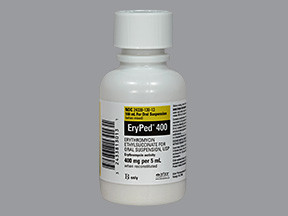
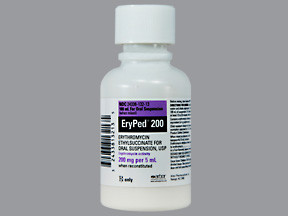

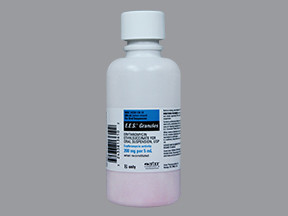
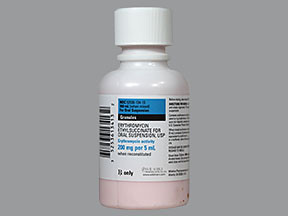


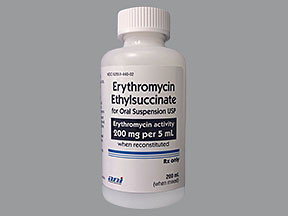
No Reviews Yet